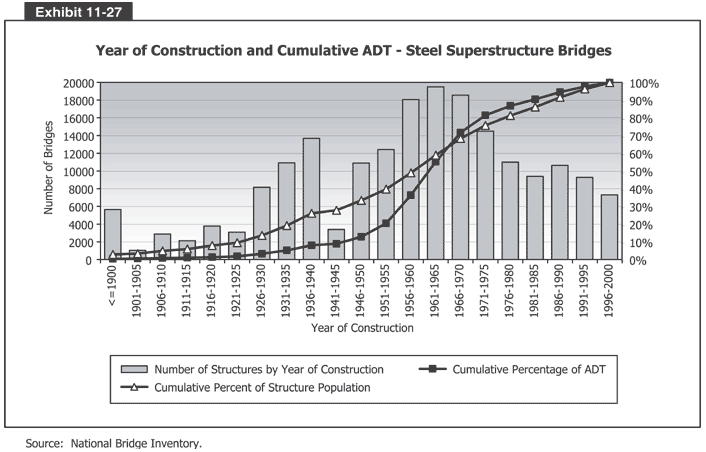U.S. Department of Transportation
Federal Highway Administration
1200 New Jersey Avenue, SE
Washington, DC 20590
202-366-4000
Conditions and Performance
Status
of the Nation's Highways, Bridges, and Transit:
2002 Conditions and Performance Report
|
Exhibit 11-27:
Year of Construction and Cumulative ADT - Steel Superstructure Bridges
 Exhibit 11-27 is a bar graph that shows the construction of steel superstructure bridges. The vertical axis measures number of bridges from 0 to 20,000 in increments of 2,000 bridges. The horizontal axis has 21 bars, one for each 5-year period between 1900 and 2000. New steel superstructure bridges were just under 6,000 before 1900. It was less than 4,000 for each period to 1925, then rose sharply to 13,800 by 1940. The figure dropped during WWII, then rose steadily again to a peak of more than 19,500 in 1956-60. The bars then decline steadily to 9,500 in 1981-85, rise to 11,000 in 1990, and drop to 7,000 in 2000. There are also two lines and a second vertical axis (measuring percentages from 0 to 100 in increments of 10 percent) in this chart. The first, representing cumulative percent of structure population, rises from 0 to 20 percent by 1935, 40 percent by 1955, 70 by 1970, 85 by 1985, and 100 by 2000. The other line, representing cumulative percentage of ADT, rises slowly from 0 to 20 percent by 1955, sharply to 70 percent by 1970 (where it overlaps the first line), and finishes at 100 by 2000 .
Exhibit 11-27 is a bar graph that shows the construction of steel superstructure bridges. The vertical axis measures number of bridges from 0 to 20,000 in increments of 2,000 bridges. The horizontal axis has 21 bars, one for each 5-year period between 1900 and 2000. New steel superstructure bridges were just under 6,000 before 1900. It was less than 4,000 for each period to 1925, then rose sharply to 13,800 by 1940. The figure dropped during WWII, then rose steadily again to a peak of more than 19,500 in 1956-60. The bars then decline steadily to 9,500 in 1981-85, rise to 11,000 in 1990, and drop to 7,000 in 2000. There are also two lines and a second vertical axis (measuring percentages from 0 to 100 in increments of 10 percent) in this chart. The first, representing cumulative percent of structure population, rises from 0 to 20 percent by 1935, 40 percent by 1955, 70 by 1970, 85 by 1985, and 100 by 2000. The other line, representing cumulative percentage of ADT, rises slowly from 0 to 20 percent by 1955, sharply to 70 percent by 1970 (where it overlaps the first line), and finishes at 100 by 2000 .
Source: National Bridge Inventory.
Back
to Chapter 11
Return to top
Page last modified on November 7, 2014
